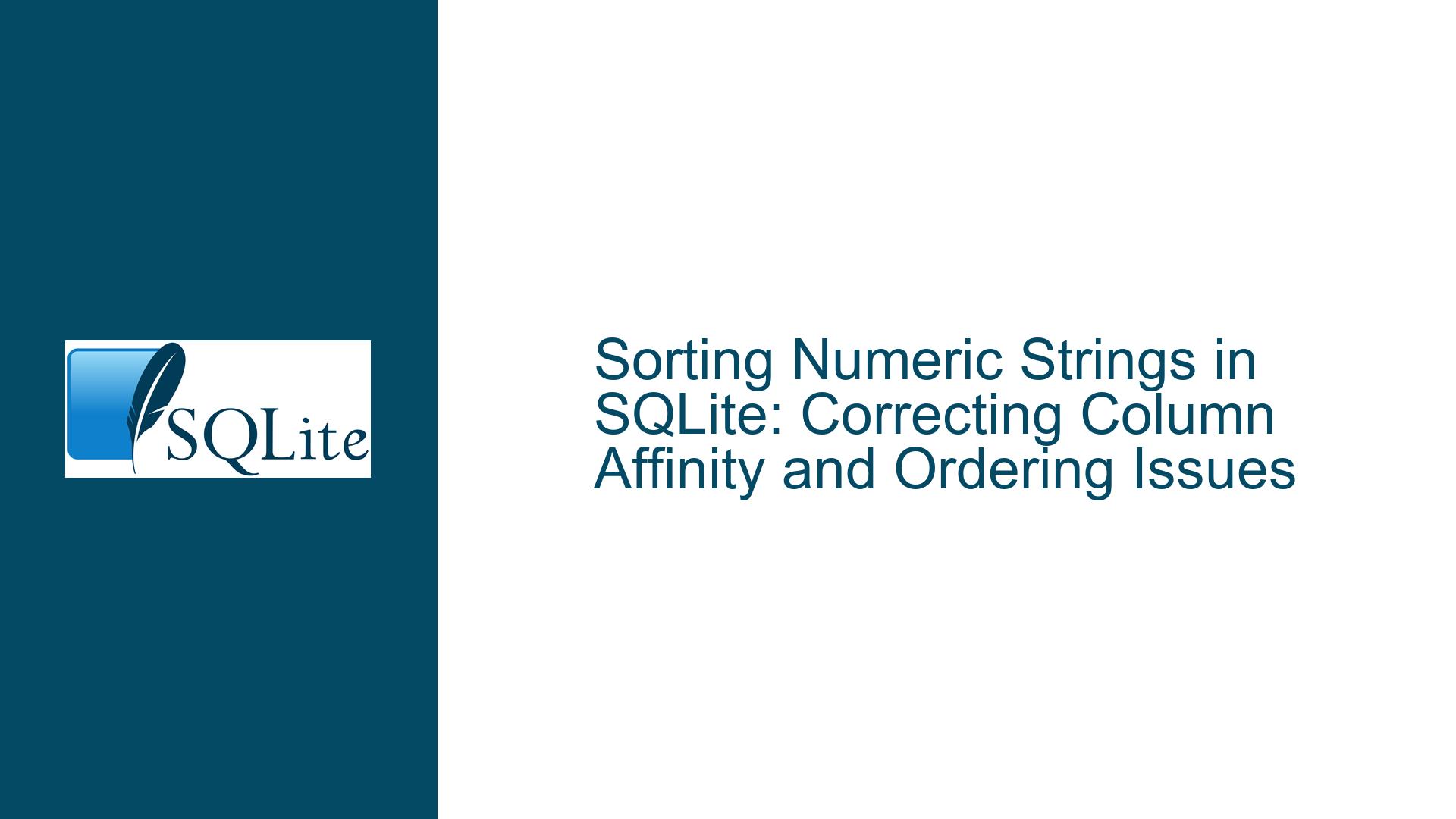Sorting Numeric Strings in SQLite: Correcting Column Affinity and Ordering Issues
Issue Overview: Sorting Numeric Strings in SQLite Queries
When working with SQLite, a common issue arises when attempting to sort numeric values that have been formatted as strings. This problem is particularly evident when using the printf function to format numeric columns into human-readable strings, such as currency values. The core issue lies in the fact that SQLite treats the output of printf as a text string, even if the string represents a numeric value. This text-based representation affects the sorting order, leading to unexpected results when using the ORDER BY clause.
For example, consider a table T1 with columns CNUM (an integer primary key) and PRICE (an integer representing prices in cents). The goal is to format the PRICE column as a decimal string (e.g., converting 1995 cents to 19.95) and then sort the results numerically. However, when using printf('%.2f', PRICE * .01) AS PRICE in the SELECT statement, the results are sorted lexicographically (alphabetically) rather than numerically. This behavior occurs because the formatted PRICE column is treated as text, and text sorting follows binary (alphanumeric) rules, not numeric rules.
The discussion highlights several attempts to resolve this issue, including using ORDER BY PRICE * .01, ORDER BY CAST(PRICE AS REAL), and ordering the results before applying the printf function. Each approach has its nuances, and understanding the underlying causes of the issue is critical to implementing a robust solution.
Possible Causes: Affinity Mismatch and Lexicographic Sorting
The root cause of the sorting issue lies in SQLite’s type affinity system and the behavior of the printf function. SQLite uses dynamic typing, meaning that the data type of a value is associated with the value itself, not the column in which it is stored. However, SQLite does assign a type affinity to each column, which influences how values are stored and compared.
When the printf function is used to format a numeric column, the result is always a text string. Even though the string represents a numeric value, SQLite treats it as text for sorting purposes. This leads to lexicographic sorting, where values are compared character by character. For example, the string "19.95" is considered "greater than" "100.00" because the character '1' in "19.95" is compared to the character '1' in "100.00", and the subsequent characters determine the order.
Another contributing factor is the use of column aliases in the SELECT statement. When a column is aliased (e.g., printf('%.2f', PRICE * .01) AS PRICE), the alias does not inherit the original column’s type affinity. Instead, the alias is treated as a new column with its own type, which is determined by the expression used to generate it. In this case, the alias PRICE is treated as text, not as a numeric value.
The issue is further complicated by the fact that SQLite does not automatically convert text representations of numbers back into numeric values for sorting. Even though the formatted PRICE column looks like a number, it is still treated as text unless explicitly converted using functions like CAST or by referencing the original numeric column in the ORDER BY clause.
Troubleshooting Steps, Solutions & Fixes: Ensuring Numeric Sorting with Formatted Strings
To resolve the sorting issue, it is essential to ensure that the ORDER BY clause operates on numeric values rather than their text representations. Below are several approaches to achieve this, along with their advantages and considerations.
1. Sorting by the Original Numeric Column
The simplest and most efficient solution is to sort by the original numeric column before applying the printf function. This approach leverages the existing numeric type affinity of the PRICE column and avoids the need for type conversion. Here is an example query:
SELECT CNUM, printf('%.2f', PRICE * .01) AS PRICE
FROM T1
ORDER BY PRICE;
In this query, the ORDER BY PRICE clause refers to the original PRICE column, which is an integer. This ensures that the results are sorted numerically. The printf function is applied after sorting, so the formatted PRICE column does not affect the sort order.
2. Using a Subquery to Pre-Sort Numeric Values
Another approach is to use a subquery to pre-sort the numeric values before applying the printf function. This method is particularly useful when additional transformations or filtering are required. Here is an example:
SELECT CNUM, printf('%.2f', PRICE * .01) AS PRICE
FROM (
SELECT CNUM, PRICE
FROM T1
ORDER BY PRICE
);
In this query, the inner SELECT statement retrieves and sorts the CNUM and PRICE columns numerically. The outer SELECT statement then applies the printf function to the pre-sorted results. This approach ensures that the sorting is performed on the original numeric values, and the formatted PRICE column is generated afterward.
3. Explicit Type Conversion with CAST
If it is necessary to sort by the formatted PRICE column, explicit type conversion can be used to ensure numeric sorting. The CAST function can convert the formatted PRICE column back into a numeric value for sorting. Here is an example:
SELECT CNUM, printf('%.2f', PRICE * .01) AS PRICE
FROM T1
ORDER BY CAST(PRICE AS REAL);
In this query, the ORDER BY CAST(PRICE AS REAL) clause converts the PRICE column to a real number before sorting. This ensures that the sorting is performed numerically, even though the PRICE column is formatted as text in the final output.
4. Indexing for Performance Optimization
When working with large datasets, indexing the PRICE column can significantly improve query performance. An index on the PRICE column allows SQLite to retrieve and sort the data more efficiently. Here is an example of creating an index:
CREATE INDEX IF NOT EXISTS price_idx ON T1(PRICE);
With the index in place, queries that sort by the PRICE column will benefit from faster execution times. However, it is important to note that indexes are only effective when sorting by the original numeric column. Sorting by a formatted text column will not utilize the index, as the index is based on the numeric values.
5. Avoiding Common Pitfalls
When implementing these solutions, it is important to avoid common pitfalls that can lead to incorrect sorting or performance issues. For example, using the ABS function on a formatted text column will not produce the desired results, as ABS operates on numeric values, not text. Here is an example of an incorrect query:
SELECT CNUM, ABS(printf('%.2f', PRICE * .01)) AS PRICE
FROM T1
ORDER BY PRICE;
In this query, the ABS function is applied to the formatted PRICE column, which is text. This will result in an error or unexpected behavior, as ABS cannot process text values. To avoid such issues, always ensure that numeric operations are performed on numeric columns or explicitly converted values.
Conclusion
Sorting numeric strings in SQLite requires careful consideration of type affinity and the behavior of formatting functions like printf. By understanding the underlying causes of lexicographic sorting and leveraging techniques such as sorting by the original numeric column, using subqueries, or explicit type conversion, it is possible to achieve the desired numeric sorting order. Additionally, indexing the numeric column can improve query performance, especially for large datasets. By following these best practices, you can ensure that your SQLite queries produce accurate and efficiently sorted results.






